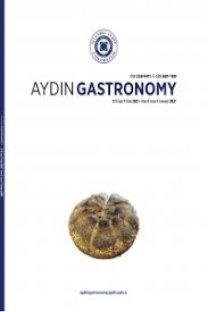Pasta Tüketen Bireylerin Pasta Tercihleri Üzerine Bir Araştırma
A Study on Cake Preferences of Cake Consuming Individuals
___
- Akkaya, L., Alişarlı, M., Kara, R., Telli, R. (2006). Afyonkarahisar’da tüketime sunulan kremalı pastalarda Listeria türlerinin varlığının belirlenmesi. Yüzüncü Yıl Üniversitesi Veteriner Fakültesi Dergisi, 17(1-2), 93-97.
- Aslan, N. (2021). Pasta ve Unlu Mamüller. İçinde: Seçim, Y., Bayrakçı S. (Ed.), İleri Mutfak Bilimleri (ss. 127-151). Ankara: Detay Yayıncılık.
- Atan, R. (2017). Dünden bugüne pastanın masalsı tarihi. https://gastromanya.com/dunden-bugune-pastanin-masalsi-tarihi/
- Coşkun, R., Altunışık, R., Yıldırım, E. (2019). Sosyal Bilimlerde Araştırma Yöntemleri, SPSS Uygulamalı. Sakarya: Sakarya Yayıncılık.
- Değirmenci-Gündoğmuş, H. (2018). Determination of reading comprehension levels of fourth grade students in terms of some variables. Social Sciences Studies Journal, 4(15), 738-743.
- Demir, G. (2008). Yükselen Hizmet Pazarlaması Uygulaması Olarak Butik Pastane İşletmeciliği ve İstanbul'daki Butik Pastaneler Üzerine Kapsamlı Bir Araştırma. Doktora Tezi, Işık Üniversitesi, Sosyal Bilimler Enstitüsü, İstanbul.
- Dizlek, H. (2013). Kremalı kek (yaş pasta) bileşenleri ve üretimi. Dünya Gıda, 6, 77-86.
- Dokuzcan, B.D. (2019). Pastacılıkta Yumurta İkamesi Olarak Nohut Suyu Kullanımı ve Yumurtasız Pandispanya Örneği. Yüksek Lisans Tezi, Okan Üniversitesi, Sosyal Bilimler Enstitüsü, İstanbul.
- Ekinci, A. (2018). Pastanın da bir tarihi var. https://www.foodtime.com.tr/makale/pastanin-da-bir-tarihi-var-m264.html
- Friberg, B. (2002). The Professional Pastry Chef: Fundamentals of Baking and Pastry. New York: John Wiley & Sons.
- Gönül, Ö. (2017). Pastacılıkta kullanılan kremalarının kalitesi. Aydın Gastronomy, 1(2), 57-66.
- Humble, N. (2010). Cake: A Global History. London: Reaktion Books.
- Karabudak, E., Başoğlu, S., Turnagöl, H., Özbay-Bedir, G., Türközü, D. (2013). Pastacılık ürünlerinin enerji ve besin değerleri ile diyet değişim listelerindeki karşılıklarının değerlendirilmesi. Gıda, 38(4), 231-238.
- Karasar, N. (2006). Bilimsel Araştırma Yöntemi. Ankara: Nobel Yayınları.
- Kaya, Z., Şahin, M. (2013). Meslek Yüksek Okulları İçin Araştırma Yöntemleri ve Teknikleri. Konya: Eğitim Yayınevi.
- Kısa, Ö., Albay, A., Erol, İ., Sırıken, B., Esin, N., Gün, H., Yurtyeri, A. (1996). Kremalı pastalardan izole edilen koagulaz (+) stafilokokların enterotoksin oluşturma özelliklerinin Vidas yöntemiyle belirlenmesi. Ankara Üniversitesi Veteriner Fakültesi Dergisi, 43, 405-411.
- Kozak, M. (2018). Bilimsel Araştırma. Ankara: Detay Yayıncılık.
- Krondl, M. (2011). Sweet Invention: A History of Dessert. Chicago: Chicago Review Press.
- Nalbant-Aydın, İ. (2013). Yeni Pazarlama Stratejileri Bağlamında Butik Pastacılık Örneği. Yüksek Lisans Tezi, Maltepe Üniversitesi, Sosyal Bilimler Enstitüsü, İstanbul.
- Öksüztepe, G., Patır, B., Çalıcıoğlu, M., İlhak, O.İ., Dikici, A. (2010). Elazığ’da satılan kremalı pastalarda E. coli O157:H7’nin varlığı. Kafkas Üniversitesi Veteriner Fakültesi Dergisi, 16(2), 307-311.
- Sancak, Y.C., İşleyici, Ö., Elibol, C., Ekici, K. (2002). Van’da tüketime sunulan kremalı pastalarda Listeria türlerinin varlığının belirlenmesi. Yüzüncü Yıl Üniversitesi Veteriner Fakültesi Dergisi, 13(1-2),8-11.
- Tuğcu, E.D. (2018). Chef Duygu Tuğcu'yla Butik Pastacılık. İstanbul: Rumuz Yayınevi.
- Wilson, C. (2005). Wedding cake: A slice of history. Gastronomica, 5(2), 69-72.
- ISSN: 2528-9411
- Yayın Aralığı: Yılda 2 Sayı
- Başlangıç: 2017
- Yayıncı: İSTANBUL AYDIN ÜNİVERSİTESİ
Yenilebilir Çiçek Olarak Gülün Önemi ve Osmanlı Mutfak Kültüründeki Yeri
Pasta Tüketen Bireylerin Pasta Tercihleri Üzerine Bir Araştırma
Görkem TEYİN, Birgül AYDIN, Murat AY, İlayda Naz ÖZAY
Tüketicilerin Gıda Güvenliği Bilinç Düzeyleri: Almanya, Macaristan ve Türkiye Karşılaştırması
Besin Hazırlama Ve Pişirme Yöntemlerinin İleri Glikasyon Son Ürünleri Üzerine Etkisi
Canan HECER, Burak ERİM, Erdi ERGENE
Turizm Alanında Gıda Okuryazarlığı Anlayışı
Grant Altay TAŞKIN, Ayşe Nevin SERT
Aybuke CEYHUN SEZGİN, Firdevs YÖNET EREN
İspanya’da Gastronomi Turizminin Tarihsel Gelişimi ve Gastrodiplomasi Değerlendirmesi
Mersin Mutfağının Gastronomik Ürünleri
Yöresel Lezzetlerin Gastronomi Turizmi Açısından Önemi: Türkiye’deki Helvalar
